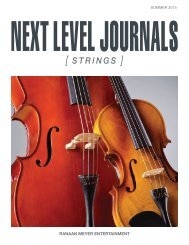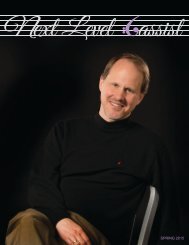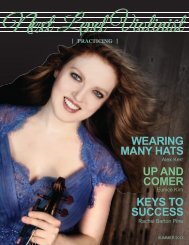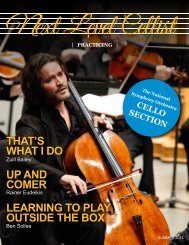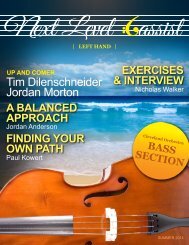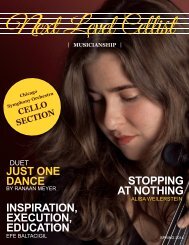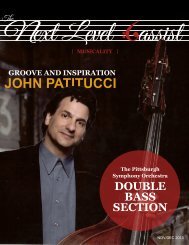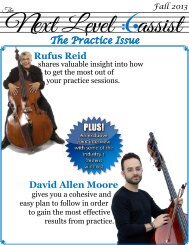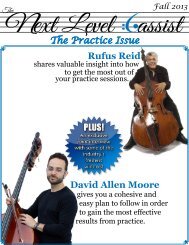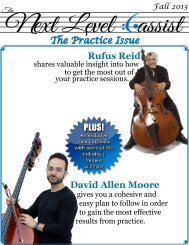SPRING 2015
You also want an ePaper? Increase the reach of your titles
YUMPU automatically turns print PDFs into web optimized ePapers that Google loves.
<strong>SPRING</strong> <strong>2015</strong>
Contents<br />
Spring <strong>2015</strong><br />
Publisher’s Note<br />
FEATURED<br />
Spotlight: Kansas City 5<br />
Symphony Orchestra<br />
Interview with Paul Katz 6<br />
CONTRIBUTORS<br />
Ranaan Meyer<br />
Publisher/Founder<br />
Brent Edmondson<br />
Editor/Sales<br />
Karen Han<br />
Art Director/Designer<br />
I<br />
couldn’t be more thrilled to be sharing the first Audition issue of<br />
Next Level Cellist with our readers all over the world. Much is made<br />
of how the audition process is fair or unfair, how its very nature creates<br />
competition in a field that is truly about collaboration, and how that<br />
competition grows year after year to an almost unsustainable level. Setting<br />
all that aside, the audition is now and has been for a long time the only<br />
path to college admission, to professional employment in an orchestra, and<br />
increasingly a means of developing a career as a freelance musician as well.<br />
Given that, it is our individual duty to learn as much about this great undertaking<br />
and to prepare ourselves to the highest level for the challenges to come.<br />
I am so grateful to Paul Katz for the time he spent in developing his article<br />
on auditions. When we began research on successful teachers, we looked at<br />
the membership of America’s largest and highest-paying orchestras. Quickly,<br />
we found a few names that came up repeatedly when reading the biographies<br />
of the cellists in each orchestra, and one name came up more than any other.<br />
Paul Katz has trained an unbelievable number of musicians to achieve success<br />
at the highest levels of American music-making, and it is no wonder when<br />
you look at his incredible resume. Beyond his experience as a member of the<br />
Cleveland String Quartet, he has a long history as a pedagogue and has gone to<br />
great lengths to create lasting resources for cellists to come through his website,<br />
www.cellobello.com. His discussion of the importance of relaxation is so spot on<br />
and valuable, and his insights on the admission process for prospective college<br />
students are a must-read.<br />
Our profile of the Kansas City Symphony touches on a very interesting<br />
subject. Many people pay attention to what the orchestras on our two coasts<br />
are doing, and miss the tremendous excitement and talent of musicians<br />
in America’s Heartland. We’re hoping to change that in our pages. The<br />
Kansas City Symphony warrants a close look and a long focused listen,<br />
not only because of its growth and expansion into a new hall in a climate of<br />
cutbacks, but because of the great musical contributions of its members.<br />
We are excited to feature the Cello Section in our spotlight!<br />
Many musicians will spend their entire careers in pursuit of audition successes.<br />
We take on the greatest challenges because it is the journey that fulfills us most<br />
deeply. Whether you are hoping to find yourself in a great college studio,<br />
or make your living as a performer, or supplement a fulfilling career with a<br />
position in a regional orchestra, auditions are the gateway to opportunity. I hope<br />
you take the messages contained here and use them to realize your dreams!<br />
RANAAN MEYER<br />
Publisher Next Level Journals<br />
Ranaan Meyer<br />
Time for Three Founder and Bassist<br />
Education We All Deserve Foundation<br />
Founder<br />
Ranaan Meyer Entertainment<br />
Indianapolis Symphony Artist in Residence<br />
Sun Valley Summer Symphony Artist<br />
and Composer in Residence<br />
Charley Creek Arts Festival Artistic Director<br />
2 NOV/DEC <strong>SPRING</strong> <strong>2015</strong> 2013 NEXT LEVEL CELLIST BASSIST<br />
<strong>SPRING</strong> <strong>2015</strong> NEXT LEVEL CELLIST 3
SPOTLIGHT<br />
JOSEPH HILL RAYMOND J. MELANSON JOSEPH CHAROTTE-MILLOT ANNE COLE<br />
NICOLAS GILLES CARLO ANTONIO TESTORE ANTOINE CAUCHE DIDIER NICOLAS<br />
BOYD POULSEN PAUL HART JAMES B. MIN CARLO CARLETTI GIOVANNI TONONI<br />
GUY COLE RENATO SCROLLAVEZZA CHRISTOPHER SANDVOSS LAWRENCE WILKE<br />
AMEDÉE DIEUDONNE DIDIER NICOLAS E.H. ROTH JOSEPH HILL W.H. HAMMIG<br />
EDWARD DANIEL TETSUO MATSUDA PAOLO ANTONIO TESTORE GAETANO COLAS<br />
BRONEK CISON DANIEL HACHEZ ANDRANIK GAYBARYAN CHRISTIAN PEDERSEN<br />
STANLEY KIERNOZIAK GIOVANNI TONONI DAVID TECCHLER WILLIAM FORSTER<br />
GUNTER VON AUE DIDIER NICOLAS JOHANNES CUYPERS J.B. VUILLAUME SACQUIN<br />
robertson reCital Hall<br />
www.RobertsonViolins.com<br />
Tel 800-284-6546 | 3201 Carlisle Blvd. NE | Albuquerque, NM USA 87110<br />
2014 Cello ColleCtion<br />
partial<br />
If you live on the East Coast in the United States, chances are your<br />
image of musicmaking in Missouri and Kansas probably involves<br />
guitars and harmonicas. In American classical music culture, a<br />
tremendous amount of focus tends to center around the Northeastern<br />
region, with old references to the “Big 5” orchestras in the country<br />
being heavily inclined toward Philadelphia, Boston, New York.<br />
The Kansas City Symphony, under the leadership of Michael Stern<br />
(son of the great violinist Isaac Stern), provides an incredible foil to<br />
that image musically rich and competently run. In addition to steady<br />
growth in wages and a stable orchestra roster, the orchestra moved to<br />
a new hall in 2011, the beautiful Helberg Hall in the Kauffman Center.<br />
With a history stretching back to the beginning of the 20 th century,<br />
including numerous incarnations and alternating stretches of<br />
expansion and contraction, the Kansas City Symphony as we know<br />
it today was founded in 1982, only a short time after the dissolution<br />
of the Kansas City Philharmonic earlier that year. Progressive at heart,<br />
the organization has embraced many modern strategies to stay<br />
relevant in today’s tumultuous climate of orchestral uncertainty.<br />
Having a world-class orchestra in a city known primarily for its<br />
barbecue and jazz music demonstrates that American treasures exist<br />
around every corner. In today’s competitive audition environment,<br />
the Kansas City Symphony and orchestras of similar size and budget<br />
are attracting applicants in the hundreds, and the ensemble’s level of<br />
musicianship is incredibly high. We spoke with newly minted cello<br />
section member Matthew Beckmann about his experiences as a<br />
member of the Symphony and what makes playing there such a treat.<br />
What type of repertoire do you feel most excited about?<br />
I am most excited about lesser known and seldom played repertoire,<br />
both contemporary and from other style periods. It is very exciting<br />
for an orchestra to add to its repertoire and explore a new piece<br />
together; those experiences are fulfilling for both the audience<br />
and the orchestra.<br />
Did you change or adapt your playing<br />
to fit in with this section?<br />
Well I have only been with the orchestra since September, so this is a<br />
work in progress! I try to balance blending with the section and fitting<br />
into its sound with making my own contributions to the style of the<br />
section. All of the members are great players individually, and it’s been<br />
exciting seeing how they adapt to different repertoire and different<br />
conductors. Flexibility is the key!<br />
How is playing with your orchestra different<br />
from playing in other orchestras?<br />
The KCS is a very close-knit group. Everyone is very supportive<br />
of each other, and especially welcoming of new members. The<br />
management and orchestra have a great relationship, and with<br />
so many cases of the opposite of that in the news these days, it’s<br />
something we’re proud of. ■<br />
4 <strong>SPRING</strong> <strong>2015</strong> NEXT LEVEL CELLIST<br />
<strong>SPRING</strong> <strong>2015</strong> NEXT LEVEL CELLIST 5
IMMANUEL & HELEN OLSHAN<br />
UNIVERSITY OF HOUSTON | MOORES SCHOOL OF MUSIC<br />
<strong>2015</strong><br />
May 29 – June 27, <strong>2015</strong> | For college and young professional musicians (ages 18–30)<br />
All participants receive a fellowship covering tuition, housing, and meals.<br />
INTERVIEW WITH<br />
PAUL KATZ<br />
RepeRtoiRe Adams Short Ride in a Fast Machine | Barber Violin Concerto | Beethoven Piano Concerto No. 3<br />
Beethoven Symphony No. 5 | DiLorenzo Phoenix for Horn and Orchestra | elgar Cockaigne Overture | prokofiev<br />
Romeo and Juliet | Schoenberg Pelleas and Melisande | Strauss Ein Heldenleben | Stravinsky The Firebird Suite<br />
Verdi La forza del destino Overture ConDuCtoRS Josep Caballé-Domenech | Franz Anton Krager | Rossen Milanov<br />
Lavard Skou Larsen SoLoiStS Glenn Dicterow, violin | Timothy Hester, piano | William VerMeulen, horn<br />
Participant Winner, Mitchell Young Artist Competition FACuLty Violin Emanuel Borok | Andrzej Grabiec<br />
Lucie Robert | Kirsten Yon | Zuo Jun Viola Wayne Brooks | James Dunham | Ralph Fielding Cello Norman Fischer<br />
Lachezar Kostov | Brinton Smith Double Bass Paul Ellison | Eric Larson | Dennis Whittaker Flute Leone Buyse<br />
Aralee Dorough oboe Robert Atherholt | Jonathan Fischer Clarinet Thomas LeGrand | Michael Webster Bassoon<br />
Richard Beene | Elise Wagner Horn Robert Johnson | William VerMeulen trumpet Mark Hughes | Thomas Siders<br />
Jim Vassallo trombone Allen Barnhill | Phillip Freeman tuba David Kirk Harp Paula Page percussion<br />
Ted Atkatz | Matthew Strauss<br />
Join today’s rising stars at the <strong>2015</strong> TMF Orchestral Institute:<br />
www.tmf.uh.edu<br />
UH is an EEO/AA Institution<br />
All programs and faculty are subject to change. For the latest updates go to www.tmf.uh.edu<br />
6 <strong>SPRING</strong> <strong>2015</strong> NEXT LEVEL CELLIST<br />
<strong>SPRING</strong> <strong>2015</strong> NEXT LEVEL CELLIST 7<br />
PhotograPhy: Jeff grass
Next Level Journals is made possible in part by Robertson and Sons Violin Shop<br />
Q: You seem to have a very comprehensive<br />
physical approach to the cello, in terms of comfort<br />
and relaxation. How did you arrive at that, and how<br />
is it important to cello playing?<br />
PK: Over the years, I’ve come to believe very strongly<br />
that mastery of the instrument comes from mastery of<br />
the fundamentals. I use Tiger Woods as an example.<br />
He’s a great golf player, and he was winning world-class<br />
tournaments, but he took about 18 months off early in his<br />
career because he wanted to change something in his<br />
swing. He made that change, and when he came back,<br />
he became the superstar that we have all come to know.<br />
That drives me a lot! My approach to teaching, which<br />
owes a lot to Janos Starker, Leonard Rose, and Bernard<br />
Greenhouse, stresses principles of healthy approach and<br />
relaxation. These principles not only keep the professional<br />
player safe during demanding and strenuous careers,<br />
but I think they also lead to a higher level of playing.<br />
Tension blocks mastery, blocks agility, blocks virtuosity.<br />
You can’t produce a beautiful sound with excessive<br />
or unnecessary tension in the hands - you are inhibited.<br />
I stress that in my teaching, the concept of healthy<br />
physical habits.<br />
Q: Can you give an example from your teaching of a<br />
problem and your approach to solving it?<br />
PK: Tension in the left hand which blocks shifting or<br />
vibrato. Tension in the right hand which blocks virtuoso<br />
bowings or string crossings, or blocking the release of<br />
arm weight so that you can’t play as loudly as you would<br />
like. In terms of stage fright or dealing with nerves, if<br />
the body is tight, you’re less prepared to cope with the<br />
additional tension of anxiety. This very often sends<br />
people past the point of no return.<br />
There are several places in the bow arm that are<br />
traditionally tight. The bow grip itself can block agility.<br />
It’s very easy to tell people not to squeeze the bow<br />
too hard, but most people do just that, stiffening their<br />
fingers. As soon as you stiffen your fingers, string<br />
crossings become angular and more difficult, and bow<br />
changes without finger flexibility become less smooth.<br />
When you tighten your bow grip, you tighten your arm<br />
and push down to play loud, instead of being able to<br />
relax down and release your arm weight into the string.<br />
As I said, it’s easy to tell someone to release their arm<br />
weight, but it’s quite another thing to do it. A tight bow<br />
grip usually happens because a student worries they<br />
will lose control if they release too much, that the bow<br />
might slip or get away from them. The other possibility<br />
is that, in the wrong way, they are looking for strength<br />
and power. My counter-measure is to tell them that the<br />
key to the bow grip is balance and flexibility, rather than<br />
strength. If the bow is balanced properly in your hand,<br />
and your fingers are sufficiently flexible to respond to<br />
changes between the A string and C string, you will have<br />
replaced the need for strength and be on your way to<br />
ultimate mastery.<br />
Q: Could you describe a remedial exercise that<br />
you employ to overcome this sort of problem?<br />
My website, www.cellobello.com, has many lessons that<br />
can help a student approach these issues.<br />
http://www.cellobello.com/lessons/12<br />
Q: When you’re considering a student to study<br />
with you, what’s the mentality you’re searching for?<br />
What makes you excited to work with someone?<br />
PK: It’s very intuitive. For me at this point, I’m looking<br />
for people I would enjoy teaching. Occasionally I’ll come<br />
across someone with an enormous talent, but I don’t feel<br />
as though I speak their language, and that is something<br />
I’ve learned not to pursue. Sometimes, I might see<br />
someone with a more modest talent, but they have<br />
something I feel like I can fix and take to the next level.<br />
That’s someone I will choose to invest in too. If I feel like<br />
I can have success in changing someone’s life or helping<br />
them over great personal hurdles, then that’s something<br />
I will also find personally rewarding. I enjoy working with<br />
musicians - I’m not interested in working on technique<br />
for technique’s sake. I care a lot about the artistic side<br />
of playing the instrument. One could get a skewed<br />
impression from the CelloBello site that technique is the<br />
primary focus, but artistry is rather hard to teach over<br />
the internet, so the lessons tend to be more technically<br />
oriented. I’m still looking for the key to discussing artistic<br />
and interpretive matters, to affecting people, through<br />
video. I do this a lot in my cello teaching. I think the<br />
reason I have several former students as principal cellists<br />
in orchestras around the country is that I think I know<br />
how to make them comfortable in expressing themselves<br />
in that position. Principal players need some personality,<br />
they need to project, they need big sounds. I like to think<br />
I can help people with that.<br />
Q: You could argue that principal players have a<br />
personality profile that’s not suited to section playing.<br />
Do you aim to impart those skills, or are you<br />
trying to enhance artists on a wider spectrum?<br />
PK: When I get a student, I’m very interested in what<br />
their career aspirations are. Some folks dream of playing<br />
in an orchestra, others are more taken by chamber music,<br />
and so on. I’m very much aware of what I’m preparing<br />
my students for, but the advice I give is that there is<br />
no way to know what doors will open for us, and what<br />
opportunities will present themselves. The best way to<br />
prepare ourselves is to become the best cellists, and the<br />
best artists, we can possibly be. Having experience in<br />
orchestra, chamber music, and solo playing ensures you<br />
are prepared for anything that comes your way. I had a<br />
career in the Cleveland Quartet, and my life was devoted<br />
to making music, so that is the direction my mind tends<br />
to head in - I cannot stand to hear unmusical playing,<br />
or a sound that isn’t beautiful.<br />
I can’t say that I’ve ever prepared a young student to<br />
become a principal cellist in an orchestra, but I’ve had<br />
former students or older professionals<br />
come to me to prepare for a principal<br />
audition. There’s a distinction there,<br />
in that preparing for these auditions<br />
is more specific and short-term goal.<br />
Q: So it sounds like aspiring to be<br />
an orchestral cellist is made easiest<br />
when you expose yourself to other<br />
styles and playing settings?<br />
PK: Absolutely, 150%! Chamber<br />
music teaches listening, and you<br />
can’t play in a major professional<br />
orchestra without listening. That’s<br />
what makes sections tight and what<br />
makes orchestras play together as<br />
a whole. I think many professionals<br />
will agree that listening to the other<br />
musicians in the group is often<br />
more important than the way the<br />
conductor is giving the beat. Ear<br />
training in the broad sense, the type<br />
of training where you learn to listen<br />
to other voices and learn to fit your<br />
part into the music, is part of chamber<br />
music success and orchestral success.<br />
It’s interesting in the world of the<br />
professional orchestra how many<br />
Famous Cellists<br />
Playing Pirastro Strings<br />
Strings Handmade in Germany<br />
www.pirastro.com<br />
ensembles have chamber music series.<br />
I think many groups have gone to<br />
that not only to keep their players<br />
happy, but because it also makes<br />
them better orchestra players. Beyond<br />
that, many orchestra auditions are<br />
beginning to require chamber music,<br />
so there seems to be a definite trend<br />
towards those skills and an obvious<br />
advantage to learning them from<br />
early on in one’s training.<br />
Q: Could you illustrate an<br />
example from the chamber<br />
music literature that would be<br />
demonstrate these benefits?<br />
PK: When you play chamber music,<br />
you learn from the experience of<br />
making music, regardless of the<br />
piece. You learn to listen to another<br />
voice, you learn to react and adjust<br />
yourself when someone else makes<br />
a change in dynamics or speed. Your<br />
reaction-based music becomes more<br />
conversational. There is an interactivity<br />
to playing this way. When you play<br />
with an extroverted player, it draws<br />
you out to play out more, and when<br />
you play with an introvert, you find<br />
yourself matching their energy in a<br />
different way. Listening and response<br />
are only half the formula, because<br />
you also learn to lead, and make<br />
your own ideas clear so that people<br />
can play with you. When you learn<br />
to give cues in chamber settings, you<br />
learn how to lead others through a<br />
solo where you want to make use of<br />
vibrato, to get someone else to feel<br />
the ritard that you are making as it<br />
happens. All of that is enormously<br />
applicable to the orchestra experience<br />
or a solo context. You can learn that<br />
from anything you play.<br />
You once quoted Mischa Schneider<br />
of the Budapest Quartet, who said<br />
“You can inspire the sound of the<br />
whole group from the cello position.”<br />
That’s one of the things we all love<br />
about the cello - you can add or<br />
subtract density from the sound,<br />
coax others into your sound world.<br />
PK: You might think of it as directing<br />
traffic. You can move the piece<br />
forward and backward. A good<br />
8 <strong>SPRING</strong> <strong>2015</strong> NEXT LEVEL CELLIST<br />
<strong>SPRING</strong> <strong>2015</strong> NEXT LEVEL CELLIST 9<br />
© Photo Jean-Baptiste Millot<br />
© Photo Aloisia Behrbohm<br />
© Photo Andreas Malkmus<br />
© Photo Andreas Malkmus<br />
© Photo Uwe Arens<br />
© Photo Christian Steiner
metaphor is being a solid foundation<br />
on which the tonal “house” is built.<br />
Your tone has to be solid and earthy<br />
enough for people to build on top of<br />
it, and the pitch needs to be focused<br />
and not diffuse so that intonation<br />
and harmony can grow out of your<br />
line - it has to be easy to tune to you.<br />
Q: What are some objective skills<br />
that you think are vital for auditioning<br />
successfully, both at the professional<br />
and at the collegiate level?<br />
PK: I think the two settings are very<br />
different, and it’s important to know<br />
and acknowledge that. Those of us<br />
that are hearing auditions by aspiring<br />
college students are mostly looking<br />
for potential. What we want to hear<br />
from a young person is a sense of<br />
integrity, caring about detail - so<br />
sloppy playing is usually not a good<br />
sign. Sloppy playing is very different<br />
from an occasional miss. You can<br />
tell if a person cares about details,<br />
and has thought about the way they<br />
make music. If they get emotionally<br />
involved, or if their inexperience<br />
causes them them to miss a note,<br />
that’s not important. What we’re<br />
looking for in a high schooler is the<br />
right value. Some of those values are<br />
totally instinctive, some of them have<br />
been instilled by a teacher.<br />
We’re looking for communicative<br />
ability, the artistic element. Some<br />
people just don’t know how to make<br />
a ritard, and their musicality reads<br />
as stiff. If I feel someone plays fairly<br />
beautifully but there are some left<br />
hand obstacles, I will gladly take<br />
that challenge on. If someone plays<br />
musically but seems a bit shy or<br />
inhibited, I can make that work.<br />
Another example is getting someone<br />
with a lot of technical mastery but<br />
difficulty in controlling their energy<br />
and temperament during a performance,<br />
which is another skill I think<br />
can be taught in this setting.<br />
There are all different scenarios from<br />
a professional audition setting. In the<br />
professional world, it comes down<br />
to the way you are playing on that<br />
given day, not the long term vision.<br />
Rhythm, intonation, sound quality,<br />
musicality - these are all key elements<br />
that need to function at high levels<br />
to have the kind of success we’re<br />
talking about in an orchestral audition,<br />
or in a solo competition. I don’t have<br />
career-long orchestral experience<br />
personally, so I rely on my former<br />
students who are in those positions<br />
to help me better understand the<br />
demands and expectations of those<br />
situations. It’s a myth that musicality<br />
is not important in an orchestral<br />
audition. The committee wants to<br />
hear music-making, a knowledge<br />
of the score and context around<br />
the excerpt, and informed phrasing<br />
on top of the basic technical skills<br />
outlined above.<br />
Q: Can you walk us through the path<br />
you might put a student on to help<br />
them perfect the fundamentals of<br />
music on their way to a successful<br />
career?<br />
PK: That’s the life of a teacher, of<br />
course! I think that it’s the instilling<br />
of values that is so important. If a<br />
person has the right values and cares<br />
about the things they are playing,<br />
they can go forward and have a<br />
wonderful life after leaving my<br />
studio. I have a freshman who is studying with me<br />
now that already possesses a wonderful temperament,<br />
beautiful sound, a communicative gift, and because of<br />
that, they have had a lot of success since an early age<br />
in playing concerts. As a result, after playing a lot of<br />
concerts, it’s becoming time to focus on the small stuff,<br />
which was a bit easier to overlook before contemplating<br />
a professional career. It’s a different ballgame! My job is<br />
to take that person and get them to hear better. Anyone<br />
with that much talent has ears, and the question is<br />
whether they are using them. If I can get a student to<br />
desire certain sounds out of their own cello, and teach<br />
them the values that will make sifting through the details<br />
clearer and more important, I will have done my job. At<br />
the moment I have another person in my studio who<br />
is just the opposite - a very musical person, and a very<br />
clean player, but extremely anal in their approach. It’s my<br />
task there to get that person to break out of their shell,<br />
play with a little risk, and avoid being so careful that the<br />
music gets lost in the details.<br />
Musicians have different balances of strengths and<br />
weaknesses, and I think the job of a good teacher is to<br />
help shore up those weaknesses and create pride and<br />
awareness of the strengths. Whether you’re walking on<br />
stage to play a concerto, an audition, or a string quartet<br />
concert, it takes guts. You have to be able to deal with<br />
stage fright, you have to draw on faith in yourself. I<br />
believe a teacher should build a student up rather than<br />
tearing him or her down, which is hard to do when you<br />
spend most of your time addressing weaknesses.<br />
You have to praise their strengths simultaneously.<br />
Q: Can you elaborate on the idea of<br />
balancing a student?<br />
PK: Imagine that the complete picture of a fine cellist<br />
and musician is made up of all the pieces we’ve discussed<br />
and many more. Everyone walks through the door with<br />
some pieces in place and some missing, and a teacher’s<br />
job is to help that person find what he or she is missing.<br />
One of the common scenarios in my studio, which<br />
is a symptom of my accepting very musical people, is a<br />
tendency towards very “approximate” rhythm. Occasionally<br />
I get a person like that whom I feel I need to gently steer<br />
away from an orchestral career, because I can sense that<br />
they are going to have a hard time winning an audition.<br />
At first I work with these students to get them to hear<br />
the difference between a triplet and a dotted eighth-sixteenth<br />
rhythm, and some people just don’t have that. It’s<br />
one of the major determining factors for success in the<br />
orchestral world.<br />
I get very fussy about rhythm in orchestral excerpts and<br />
certain instances of the solo cello repertoire, particularly<br />
the Beethoven sonatas and the Haydn concerti. Rhythm<br />
as an artistic tool goes beyond simple objective decisions<br />
like this though. You need to determine whether the<br />
music flows like water, or sits up straight in a military<br />
fashion, or pulls back as in a Brahms sostenuto. This is<br />
the sort of rhythm I teach all the time. I try to describe<br />
composers in terms of how their music moves.<br />
Mendelssohn to me is perhaps the most “flowing” and<br />
forward feeling. Beethoven has a rhythmic power which<br />
depends upon precision, and Brahms tends to sit on the<br />
back of the beat. I teach these through repertoire because<br />
it is the most effective way to grasp the nuance of these<br />
distinctions. I teach rhythm through scales as well, by<br />
imposing rhythms on scales such as the Galamian pattern<br />
of 2+3+6 (2 eighths, 3 triplets, 6 sextuplets). You can mix<br />
this pattern up and find tremendous variety and challenge.<br />
I also like to have my students play scales in fives and<br />
sevens as well, because I think there is a musical<br />
application for this.<br />
One of the most frustrating things about teaching<br />
is that there’s never enough time to do all the things<br />
that need to be done.<br />
The way I teach intonation is by teaching listening<br />
awareness. Your intonation depends on how sharply you<br />
are listening for it. I think of a high level of intonation as<br />
a way of life. It’s in your scales, solo playing, chamber<br />
music, orchestral music. Intonation has to be something<br />
the ear is picking up all of the time. It’s too important to<br />
say that it’s background. It’s always present, it’s always<br />
in your consciousness, there’s so much more that goes<br />
on that it can’t be your major focus. If it’s the only thing<br />
you are aware of then things get tight and small, music<br />
doesn’t get made, and sound becomes less beautiful.<br />
One of the mistakes out there is that people think of<br />
concentration in terms of thinking. Thinking gets in the<br />
way of what we do - we can think about a bow change,<br />
a shift, tempo, playing with the others in our ensembles,<br />
but we can only do one at a time. The best the mind is<br />
capable of doing is quickly flitting from one thing to the<br />
next. I just don’t believe you can ever have comfortable,<br />
natural playing that way. I think the way we can keep<br />
track of all that stuff simultaneously is through the ears.<br />
The ears are kind of a miracle. They can hear intonation,<br />
rhythm, sound production, ensemble, and everything else<br />
simultaneously, and they can adjudicate it simultaneously.<br />
Tremendous listening awareness means expanding what<br />
the ears take in.<br />
If intonation becomes a preoccupation, it can be a<br />
negative. Being afraid to play out of tune hampers<br />
your musical career, and yet you’re expected to play in<br />
tune at all times. There’s a psychological balance, and a<br />
way of thinking (or not thinking) that can allow you to<br />
paradoxically use your ear and hand training to work in<br />
harmony. You have to be constantly aware of intonation,<br />
but only in the larger context of the whole experience,<br />
rather than excluding other elements from your focus<br />
to isolate intonation.<br />
I have this story I tell on my website - when I go out on<br />
stage to play, I have this image of my ears growing very<br />
large, expanding on my head until they’re huge. They<br />
become like vacuum cleaners, sucking up all the sounds<br />
around me so that nothing can escape my ears. That is<br />
how I visualize the acute level of hearing that I think is<br />
necessary to control everything you are doing. You can<br />
make a shift and feel the distance to get yourself close<br />
10 <strong>SPRING</strong> <strong>2015</strong> NEXT LEVEL CELLIST<br />
<strong>SPRING</strong> <strong>2015</strong> NEXT LEVEL CELLIST 11
to the right note, but if you wiggle your finger a little to<br />
either side, you’re no longer in the right place, so feeling<br />
isn’t enough. Your ear is the final adjudicator for that last<br />
bit of precision, which comes from such a small muscular<br />
movement, to reach precision. If you make a crescendo,<br />
your ears help regulate how much crescendo you make,<br />
just as they regulate the magnitude of an accent. Everything<br />
has to be decided by the sound, and thus it all comes<br />
back to the ears.<br />
Q: How do you build the musical sensibility<br />
that allows your ears to make these decisions?<br />
PK: I think it comes from a variety of experiences,<br />
including listening to recordings, seeing live performances<br />
by great musicians, studying scores, listening to your<br />
teachers, and experimentation on your own. I think that<br />
today’s generation plays at a generally higher level than<br />
my generation. Of course, mastery is mastery, but when<br />
you look at the general population you see the difference<br />
in aggregate. On a typical day of high school students<br />
auditioning for a school, everybody plays so well. Part of<br />
that is due to teaching, but a large part is also because<br />
of digital sound and the accessibility afforded by resources<br />
like Youtube. A student today can sit at home and listen<br />
to in-tune string quartets, immortal performances of<br />
all the repertoire - I think conceptually this has had an<br />
impact on the way young people think they want to<br />
sound. Aside from this, you also need the ears of a<br />
teacher. I have spent a career steeped in tradition, in<br />
the sounds of Beethoven and Brahms, and I’m part of<br />
the older generation that is passing on knowledge to the<br />
younger. The whole mentoring system is so important in<br />
terms of teachers with high standards and ideals making<br />
students listen, challenging them on tradition and style.<br />
Musicians are also influenced by the people they play<br />
with, and the people they play for as well. It’s basically<br />
life that helps mature people the most. I think the mistake<br />
is made when somebody chooses one path, like only<br />
going to concerts to develop ideas. For all the amazing<br />
good that Youtube and other digital resources can<br />
provide, it’s totally different from going to concerts and<br />
experiencing wonderful cellists playing in that acoustic.<br />
The communicative aspect of a performer’s charisma,<br />
the tone in the room, the sensation of the performance,<br />
that is all irreplaceable. ■<br />
12 <strong>SPRING</strong> <strong>2015</strong> NEXT LEVEL CELLIST




